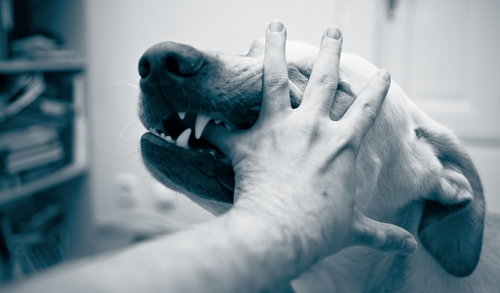Human and animal bites are relatively common and can result in minor injuries such as puncture wounds, scrapes, cuts or bruising. They most commonly occur to the face, hands, arms and legs. The primary concern for these bites is infection, which can usually be avoided with proper cleaning and treatment. Most human and animal bites can be treated with basic first aid techniques at home.
How Animal Bites Occur
Animal bites occur most frequently when caution is not taken around an animal. Often times the animal (such as a dog or cat) is known to the individual, but may feel threatened temporarily and act out of self defense. In some cases, animal bites can occur from seemingly unprovoked animals, wild or domesticated. Human bites can occur for a variety of reasons. Children may bite playfully or as misbehavior. Adult bites may occur due to confrontations or as an act of self defense, and can also sometimes happen accidentally.
Types of Animal Bites
The most common types of bites are:
Dog bites – Dog bites are most common in school-aged children who may approach animals with less caution than adults. Often, the dog is known to the individual, who may interfere with it while it sleeps or eats and cause a provocation.
Cat bites – Cat bite puncture wounds are usually deeper than dog bites and have a greater risk of infection.
Livestock bites – Livestock, such as horses, mules, cows or sheep can cause crushing injuries with their powerful jaws, though these bites are less likely to puncture the skin.
Wild animal bites – These bites can occur during outdoor activities such as hunting, fishing or camping and can cause a wide variety of injuries from minor to serious depending upon the animal (i.e. raccoon, opossum, fox).
Snake bites – Snake bites can occur in gardens and yards or on outings to many different types of outdoor areas where activities disturb snakes that are hiding under rocks, fallen trees or vegetation. If you know a snake is not venomous, you should treat the snake bite as a puncture wound, but contact your health provider as soon as possible, in case a tetanus shot is needed. Be sure to note the snake's appearance in the event that you need to describe it to medical staff. If the snake is venomous, the patient will need to receive immediate anti-venom treatment.
Human bites – Human bites can be the cause of one person coming into contact with another person’s teeth, as can occur when a fist punches a mouth (also called a “fight bite”). These bites can become infected and should be thoroughly disinfected. Human bites caused by children are often more superficial but should be treated with equal caution.
Signs and Symptoms
Symptoms of a human or animal bite include:
- Bleeding
- Puncture Wound
- Bruising
- Lacerations
Who Is at Risk
Those who are physically aggressive are typically more at risk for adult human bites. Child human bites can occur most frequently to:
- Childcare Providers
- Teachers
- Parents
- Other children (siblings or peers)
Animal bites occur most frequently to school-aged children. Boys are bitten about twice as often as girls. Animals that pose a risk for biting include, but are not limited to:
- Dogs
- Cats
- Raccoons
- Opossum
- Skunks
- Foxes
- Bears
- Bats
Treatment Options for Animal Bites
All animal and human bites need immediate medical attention unless they are very minor. This is because the high level of bacteria introduced by the bite itself can easily cause infection quickly. As soon as possible, do the following:
- For snake bites, do not clean or disturb the wound in any way. To prevent any venom from spreading, keep the patient immobile until emergency medical personnel arrive
- Gently clean away any dirt
- Flush the wound with at least 16 ounces of sterile saline with a syringe. These items can be found at a local pharmacy or drug store. Use as much force with the syringe as can be tolerated without pain. (In cases where sterile saline is not accessible rinsing with water and gently cleansing with soap is appropriate.)
- Stop the bleeding
- Apply an antibiotic ointment
- Clean at least once daily until healed
Call a doctor or seek other professional medical attention the same day for the following:
- Any snake, spider or insect bite that may be venomous
- Any animal or human bite to the face, fingers or toes, unless it is a very minor scrape
- Any deep puncture bite, such as might be caused by a cat’s long, sharp teeth
- Any large bite or tear that seems to need stitches for proper closure and healing
In some cases, a medical professional may recommend further treatment such as:
- Oral antibiotics
- Rabies shots
- Anti-venom shots
- Tetanus shot
- Stitches
- Prescription ointment
Preventing Bites
Because the majority of animal bites occur to young children, teaching them that animals may hurt them is the best prevention. Teaching children to treat animals respectfully and with caution alerts them to the fact that even the family dog can bite in certain instances. Other ways to help prevent human and animal bites include:
- Teach children not to bite
- Teach children to avoid disturbing large rocks or playing in areas where snakes hide
- Do not provoke or tease animals
- Do not approach strange animals
- Do not approach familiar animals when they are eating or fighting with other animals


